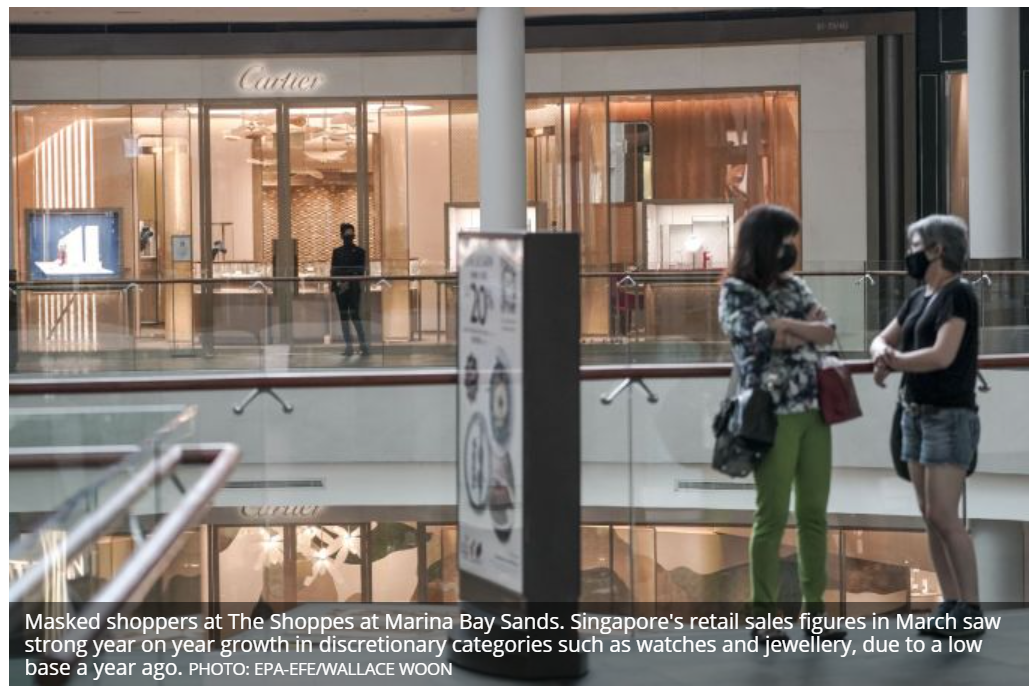Singapore: Retail sales recovery after March’s 6.2% growth depends on Covid-19 measures: economists
SINGAPORE retail sales rose 6.2 per cent year on year in March, with a low base effect likely to boost April’s figures as well, said economists.
But the trajectory from there will depend on whether the tightened Covid-19 measures in May persist beyond their intended three-week duration, they added.
“While April data is likely to look fantastic due to the low base last year, the concern will be if the restrictions get extended or the Covid situation improves so we can revert to Phase 3 conditions in June,” said OCBC head of treasury research and strategy Selena Ling.
Maybank Kim Eng economist Chua Hak Bin noted while retail sales are improving, this “remains capped by social distancing, border controls and a sluggish labor market recovery”.
Released by the Singapore Department of Statistics (SingStat) on Wednesday, the March figures fell short of economists’ expectations of 7.1 per cent growth, but marked the second straight month of growth.
Retail sales growth had been 5.3 per cent in February and -6.1 per cent in January, with the differing dates of the Chinese New Year festive season accounting for some of the fluctuation.
Total retail sales value in March was S$3.5 billion, of which 11.8 per cent was from online sales. Excluding motor vehicles – which saw a 15.6 per cent growth in sales – retail sales rose 4.4 per cent, slowing from February’s 7.8 per cent growth.
On a month-on-month seasonally adjusted basis, retail sales rose 3 per cent, or 2.2 per cent excluding motor vehicles.
March’s year-on-year growth figures were shaped by the base conditions a year ago, when Covid-19 border restrictions started to kick in.
In its statement, SingStat noted larger sales growth in discretionary categories such as watches and jewellery (60.2 per cent) and wearing apparel and footwear (35.6 per cent), “due to the lower base in March 2020 when there were low tourism receipts arising from tightened border restrictions”.
Other categories that saw growth were recreational goods (28.3 per cent), computer and telecommunications equipment (19.9 per cent) and petrol service stations (18.6 per cent).
Seeing smaller rises were optical goods and books (2.9 per cent), and furniture and household equipment (1.8 per cent).
In contrast, sales at supermarkets and hypermarkets fell 14 per cent year on year, “compared to March 2020 when there were higher sales as more people stayed home after safe distancing measures were introduced”.
Sales also fell for department stores (-4.2 per cent); food and alcohol (-8.4 per cent); cosmetics, toiletries and medical goods (-13.2 per cent); mini-marts and convenience stores (-6 per cent) and others (-7.1 per cent).
Total food and beverage sales were S$730 million, up 8 per cent year on year, or 4 per cent on a month-on-month seasonally adjusted basis.
This was led by a 17.9 per cent growth in restaurant sales, attributed to the low base a year ago when safe-distancing measures were introduced.
Also seeing higher sales were fast food outlets (5.5 per cent) and cafes, food courts, and other eating places (5.6 per cent). But food caterers saw sales fall 25 per cent year on year, as demand for event catering remains low.
On Tuesday, the multi-ministry taskforce announced the return of tighter Covid-19 measures from May 8 through May 30, including a five-person cap on social gatherings, and no more than 50 per cent of employees who can work from home being allowed back to workplaces.
The May retail sales data “may hit a temporary speed bump” due to these measures, said Ms Ling. Demand for F&B, wearing apparel, and department stores may be affected by the lower cap on employees who are allowed to return to the workplace, she added.
OCBC is lowering its full-year retail sales growth forecast to 11 per cent, down from 12 per cent previously, factoring in the expected dent in May.
Dr Chua said the tightened measures “will probably only have a small impact on retail sales, as shoppers can shop online, but may have a more visible impact on F&B”.
While he expects double-digit retail sales growth in the second quarter due to the low base effect from last year’s circuit breaker, he also expects the sales level to remain below pre-pandemic levels.
Source: https://www.businesstimes.com.sg/government-economy/retail-sales-recovery-after-marchs-62-growth-depends-on-covid-19-measures


 English
English




